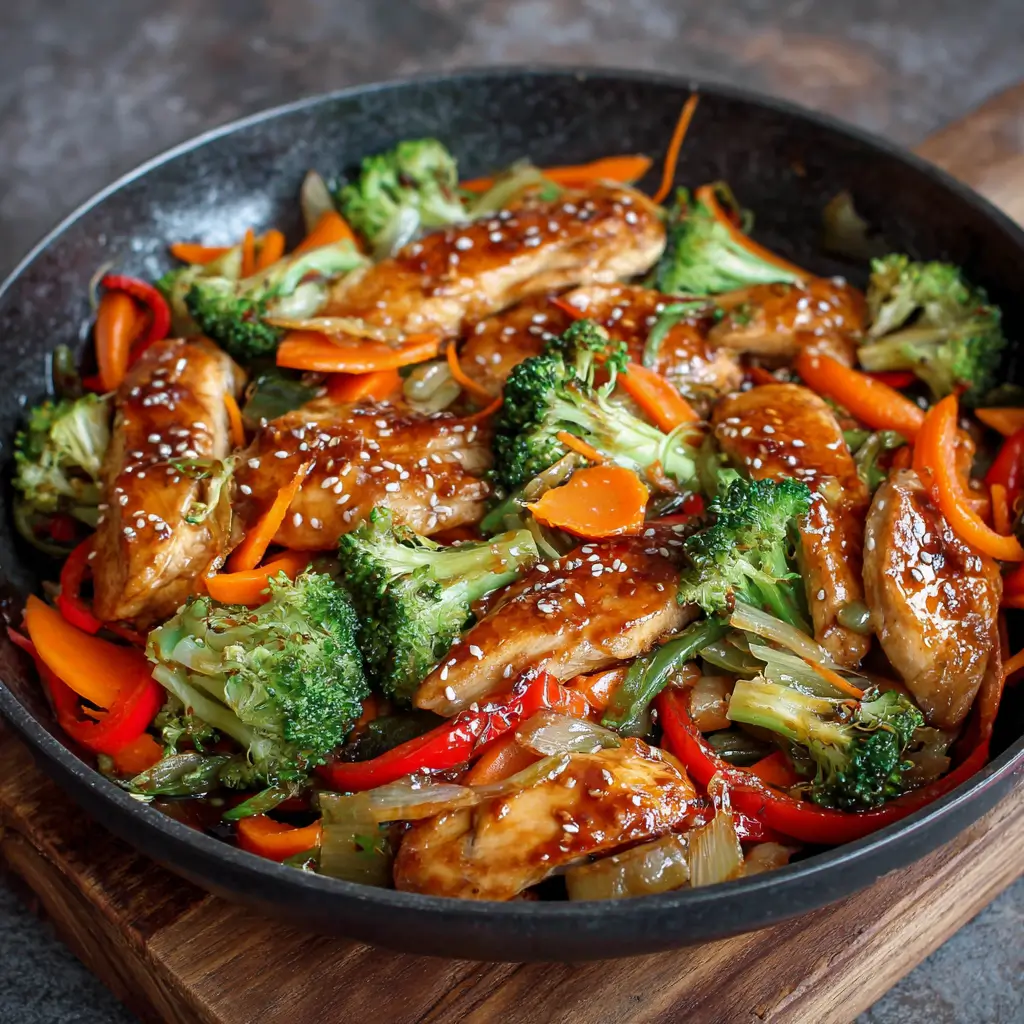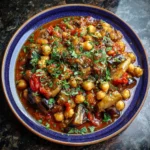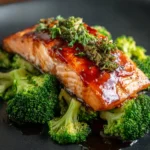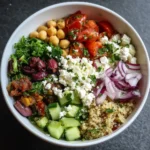Introduction
Teriyaki Chicken with Vegetables is a beloved dish that brings together the savory-sweet essence of Japanese cuisine with vibrant, nutritious vegetables in perfect harmony. Known for its glossy glaze and tender chicken, this dish has become a staple not only in Japan but across the globe, especially in North American homes and restaurants. It’s an ideal weeknight dinner option—quick to prepare, packed with flavor, and endlessly customizable. Whether you’re a seasoned home cook or just beginning your culinary journey, this recipe offers a delicious balance of simplicity and sophistication.
The History
The word “teriyaki” comes from two Japanese words: teri, meaning luster or shine, and yaki, meaning grilled or broiled. Originally, teriyaki referred to a cooking technique where fish (often salmon or mackerel) was broiled or grilled with a glaze made from soy sauce, mirin, and sugar. This method dates back to the Edo period (1603–1868), when cooks began using natural sugars and fermented sauces to enhance the appearance and taste of grilled foods.
Over time, the teriyaki style expanded beyond fish to include meats such as chicken, beef, and pork. With increased global trade and cultural exchange during the 20th century, teriyaki gained popularity outside Japan, particularly in Hawaii and the United States. Hawaiian immigrants adapted the traditional recipe by adding pineapple juice and other local ingredients, creating a sweeter version that eventually influenced mainland American palates.
Today, teriyaki chicken stands as one of the most recognizable Japanese-inspired dishes worldwide. While purists may argue about authenticity, modern interpretations often blend tradition with convenience—using bottled sauces or quick-cook methods—while still honoring the core principles of balance, umami, and visual appeal.
Ingredients Breakdown
The magic of Teriyaki Chicken with Vegetables lies in the synergy between high-quality ingredients and their balanced proportions. Let’s take a closer look at each component:
- Chicken Breast or Thighs: Boneless, skinless chicken breasts are lean and widely preferred for their mild flavor and ease of slicing. Alternatively, chicken thighs offer more juiciness and depth due to their higher fat content, making them excellent for longer cooking times or grilling.
- Soy Sauce: The backbone of the teriyaki sauce, soy sauce provides saltiness and umami. Use low-sodium soy sauce if you want better control over the salt level, or opt for tamari for a gluten-free alternative.
- Mirin: A sweet rice wine essential for authentic teriyaki flavor. It contributes both sweetness and a subtle tang. If unavailable, a mix of dry white wine and sugar can be substituted, though it won’t replicate mirin’s unique profile exactly.
- Sake or Rice Vinegar: Sake enhances the complexity of the sauce while tenderizing the chicken slightly. In its absence, rice vinegar works well as a non-alcoholic substitute, offering similar acidity without the alcohol content.
- Brown Sugar or Honey: Adds sweetness and helps create the signature glossy finish when reduced. Brown sugar imparts a caramel-like depth, while honey adds floral notes and extra shine.
- Fresh Ginger and Garlic: These aromatics form the flavor foundation. Grated fresh ginger adds warmth and zing, while minced garlic brings pungency and richness. Avoid pre-minced versions for optimal taste.
- Cornstarch: Used as a thickening agent to give the sauce its velvety consistency. Mixed with water into a slurry, it prevents clumping and ensures smooth integration into the simmering sauce.
- Vegetable Oil: For sautéing the chicken and vegetables. Neutral oils like canola, grapeseed, or avocado oil work best due to their high smoke points.
- Assorted Vegetables: Common choices include bell peppers (red, yellow, green), broccoli florets, carrots, snap peas, mushrooms, zucchini, and onions. These add color, texture, fiber, and vital nutrients to the dish.
- Sesame Seeds and Green Onions (Garnish): Optional but highly recommended for finishing touches. Toasted sesame seeds add nuttiness and crunch, while sliced green onions contribute freshness and visual appeal.
Step-by-Step Recipe
- Prepare the Teriyaki Sauce: In a small bowl, whisk together ½ cup soy sauce, ¼ cup mirin, ¼ cup sake (or rice vinegar), 3 tablespoons brown sugar (or honey), 1 tablespoon grated fresh ginger, and 2 cloves minced garlic. Set aside.
- Make the Cornstarch Slurry: In another small bowl, combine 1 tablespoon cornstarch with 2 tablespoons cold water. Stir until smooth and set aside for later use.
- Marinate the Chicken (Optional but Recommended): Cut 1 pound of boneless chicken into bite-sized pieces. Place in a bowl and pour half of the prepared teriyaki sauce over it. Toss to coat evenly and let marinate for at least 15 minutes (or up to 2 hours in the refrigerator for deeper flavor).
- Cook the Chicken: Heat 1 tablespoon of vegetable oil in a large skillet or wok over medium-high heat. Remove chicken from marinade (reserve leftover marinade) and cook in batches to avoid overcrowding. Sear for 5–7 minutes, turning occasionally, until golden brown and cooked through (internal temperature should reach 165°F). Transfer cooked chicken to a plate and set aside.
- Sauté the Vegetables: In the same pan, add another teaspoon of oil if needed. Add chopped vegetables starting with those that take longer to cook—such as carrots and broccoli—followed by quicker-cooking ones like bell peppers, snap peas, and mushrooms. Cook for 5–6 minutes, stirring frequently, until crisp-tender. You may splash a little water or broth to steam softer vegetables if desired.
- Combine and Simmer: Return the cooked chicken to the pan with the vegetables. Pour in the reserved marinade (which now contains raw chicken juices) along with the remaining teriyaki sauce. Bring to a gentle boil.
- Thicken the Sauce: Slowly drizzle in the cornstarch slurry while stirring constantly. Reduce heat to low and continue stirring for 1–2 minutes until the sauce thickens and coats the ingredients evenly.
- Taste and Adjust: Give the dish a final taste. Add a pinch more sugar for sweetness, a splash of soy sauce for saltiness, or a dash of rice vinegar for brightness, depending on your preference.
- Garnish and Serve: Sprinkle with toasted sesame seeds and thinly sliced green onions. Serve immediately over steamed white rice, brown rice, quinoa, or cauliflower rice for a low-carb option.
Tips
- Don’t Overcrowd the Pan: When searing chicken, cook in batches to ensure proper browning. Overcrowding causes steaming instead of searing, leading to soggy texture.
- Use Fresh Aromatics: Freshly grated ginger and minced garlic make a noticeable difference compared to powdered versions.
- Balance the Sweetness: Teriyaki should be savory first, sweet second. Be cautious with added sugar—taste as you go.
- Reserve Marinade Safely: Since the marinade contacts raw chicken, always bring it to a rolling boil before incorporating it into the final dish to kill any bacteria.
- Prep Ahead: Chop all ingredients before starting. This stir-fry moves quickly once cooking begins.
- Double the Sauce: Many people love extra sauce for drizzling over rice. Consider doubling the sauce portion if serving to guests.
- Control Thickness: If the sauce becomes too thick, thin it with a little water or broth. Conversely, if too thin, mix additional cornstarch (½ tsp + 1 tsp water) and stir in gradually.
Variations and Customizations
One of the greatest strengths of Teriyaki Chicken with Vegetables is its adaptability. Here are some popular variations to suit different tastes and dietary needs:
- Pineapple Teriyaki: Add diced fresh pineapple or pineapple juice to the sauce for a tropical twist. Pairs wonderfully with bell peppers and red onion.
- Spicy Teriyaki: Infuse heat by adding sriracha, chili flakes, or a finely chopped fresh red chili to the sauce.
- Vegetarian/Vegan Option: Replace chicken with tofu, tempeh, or seitan. Use maple syrup instead of honey and ensure soy sauce is vegan-friendly.
- Gluten-Free Version: Substitute regular soy sauce with tamari or a certified gluten-free soy sauce. Check all labels for hidden gluten sources.
- Low-Sugar/Keto-Friendly: Use a sugar substitute like erythritol or monk fruit in place of brown sugar, and reduce overall sweetness. Serve over spiralized zucchini noodles.
- Grilled Teriyaki Chicken: Marinate chicken and grill over medium heat, basting with sauce during the last few minutes. Grill vegetables separately on skewers or a grill basket.
- Baked Version: Arrange chicken and vegetables on a sheet pan, brush with teriyaki sauce, and bake at 400°F for 20–25 minutes, flipping halfway through.
- Slow Cooker Method: Combine all ingredients (except cornstarch slurry) in a slow cooker and cook on low for 4–5 hours. Thicken sauce at the end on the stovetop.
- Noodle Bowl Style: Toss cooked soba, udon, or ramen noodles with the teriyaki mixture for a hearty one-bowl meal.
- Meal Prep Friendly: Prepare components separately and store in containers. Reheat and combine when ready to eat—ideal for lunches throughout the week.
Health Considerations and Nutritional Value
Teriyaki Chicken with Vegetables can be a wholesome, nutrient-dense meal when prepared thoughtfully. Here’s a breakdown of key health aspects:
- Protein Source: Chicken breast is a lean source of high-quality protein, essential for muscle repair and satiety. One serving (about 4 oz) provides approximately 35 grams of protein.
- Vegetables Galore: Incorporating a rainbow of vegetables boosts intake of vitamins A, C, K, folate, potassium, and dietary fiber—all important for immune function, digestion, and heart health.
- Healthy Fats: Using minimal oil and avoiding deep frying keeps fat content moderate. Sesame seeds add beneficial unsaturated fats and minerals like calcium and magnesium.
- Sodium Awareness: Soy sauce is naturally high in sodium. To reduce intake, use low-sodium soy sauce, limit portions, or dilute with water or broth. Rinsing canned vegetables (if used) also helps lower sodium levels.
- Sugar Content: Traditional teriyaki sauce contains significant sugar. To minimize added sugars, reduce the amount in the recipe or use natural sweeteners in moderation.
- Balanced Meal: When served with whole grains like brown rice or quinoa, this dish offers complex carbohydrates, sustained energy, and improved glycemic control.
- Allergen Notes: Contains soy and wheat (unless gluten-free substitutes are used). Always check labels if serving individuals with food allergies.
- Portion Control: Stick to a 3–4 oz serving of chicken and fill half your plate with vegetables for optimal nutrition.
Approximate Nutritional Values per Serving (with chicken breast, mixed vegetables, ½ cup sauce, served over ½ cup white rice):
- Calories: 420–480
- Protein: 35–40g
- Carbohydrates: 45–55g
- Fat: 10–14g (mostly unsaturated)
- Sodium: 900–1,200mg (varies based on soy sauce type)
- Sugars: 12–18g (including natural and added)
Ingredients
- 1 lb (450g) boneless, skinless chicken breasts or thighs, cut into 1-inch cubes
- 3 tbsp vegetable oil, divided
- 1 red bell pepper, sliced
- 1 yellow bell pepper, sliced
- 1 cup broccoli florets
- 1 medium carrot, julienned or thinly sliced
- 1 cup snap peas
- ½ cup sliced mushrooms (shiitake or button)
- ½ small onion, sliced
- ⅓ cup soy sauce (low-sodium preferred)
- ¼ cup mirin (sweet rice wine)
- ¼ cup sake or rice vinegar
- 3 tbsp brown sugar or honey
- 1 tbsp freshly grated ginger
- 2 cloves garlic, minced
- 1 tbsp cornstarch
- 2 tbsp cold water
- Toasted sesame seeds, for garnish
- Sliced green onions, for garnish
- Cooked rice or grain of choice, for serving
Directions
- In a mixing bowl, whisk together soy sauce, mirin, sake (or rice vinegar), brown sugar, grated ginger, and minced garlic. Reserve ½ cup of this sauce for cooking; pour the rest over the chicken to marinate for 15–30 minutes.
- While chicken marinates, chop all vegetables and set aside. Mix cornstarch with 2 tablespoons of cold water in a small bowl to make a slurry.
- Heat 1 tablespoon of oil in a large skillet or wok over medium-high heat. Remove chicken from marinade (shaking off excess) and cook in batches until golden and cooked through (about 6–7 minutes). Transfer to a plate.
- Add another teaspoon of oil to the same pan. Sauté harder vegetables (carrots, broccoli) first for 2–3 minutes, then add softer ones (bell peppers, snap peas, mushrooms, onions). Stir-fry for 4–5 minutes until crisp-tender.
- Return chicken to the pan. Pour in the reserved ½ cup teriyaki sauce and bring to a simmer. Stir in the cornstarch slurry and cook for 1–2 minutes until the sauce thickens and coats everything evenly.
- Taste and adjust seasoning—add more sugar for sweetness or a splash of vinegar for balance.
- Remove from heat. Garnish with toasted sesame seeds and sliced green onions.
- Serve hot over steamed rice or your favorite grain.
FAQ
Q: Can I use store-bought teriyaki sauce?
A: Yes, you can! However, homemade sauce allows you to control sugar, salt, and preservatives. Store-bought versions often contain additives and higher sodium levels.
Q: How do I prevent my sauce from being too salty?
A: Use low-sodium soy sauce, dilute with a bit of water or broth, and balance with a touch more sweetness or acidity (like lemon juice).
Q: Can I freeze teriyaki chicken?
A: Absolutely. Cool completely and store in airtight containers for up to 3 months. Reheat gently on the stove or microwave, adding a splash of water to refresh the sauce.
Q: Is teriyaki chicken healthy?
A: When made with lean chicken, plenty of vegetables, and controlled amounts of sugar and sodium, it can be part of a balanced diet. Opt for whole grains and generous veggies to boost nutritional value.
Q: What can I substitute for mirin?
A: Mix 1 tbsp rice vinegar with 1 tsp sugar per ¼ cup mirin. Avoid dry sherry or apple juice, which alter flavor significantly.
Q: Can I make this in advance?
A: Yes. Marinate chicken overnight, chop vegetables ahead, and prepare sauce up to 3 days in advance. Assemble and cook when ready to serve.
Q: Why did my sauce turn out too thick or too thin?
A: Too thick? Add warm water or broth, 1 tablespoon at a time. Too thin? Make a new slurry (½ tsp cornstarch + 1 tsp water) and stir in slowly while simmering.
Q: Can I use frozen vegetables?
A: Yes, but thaw and pat dry first to prevent excess moisture. They may cook faster than fresh, so add toward the end.
Summary
Teriyaki Chicken with Vegetables is a flavorful, versatile, and nutritious dish that combines tender chicken in a glossy sweet-savory sauce with colorful, crisp-tender vegetables. Easy to customize and perfect for weeknights, meal prep, or entertaining, it brings the taste of Japan straight to your kitchen table.










